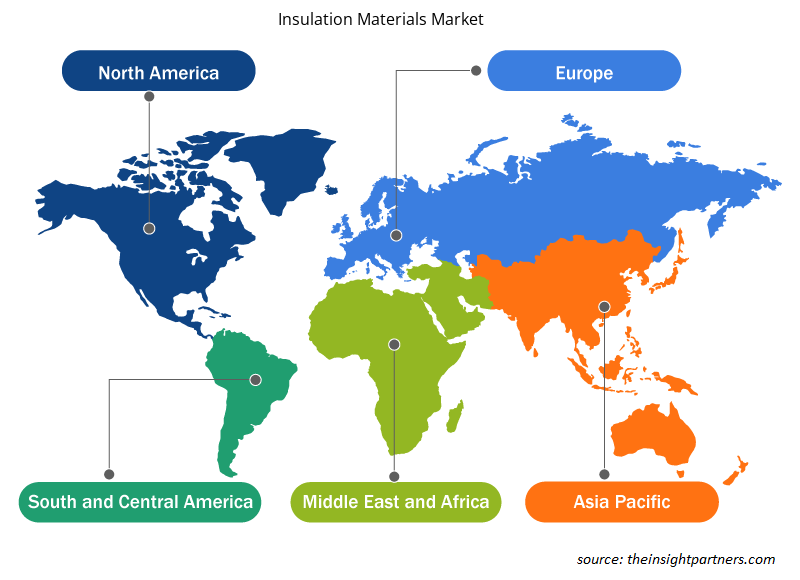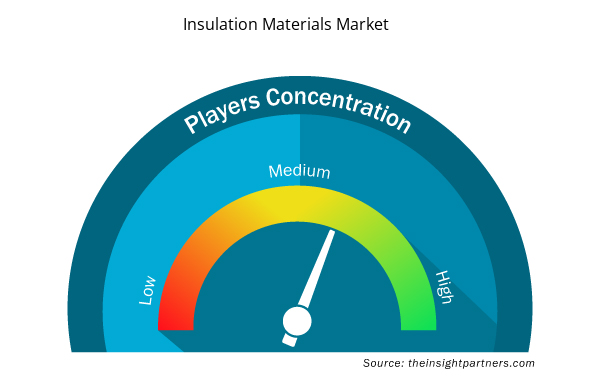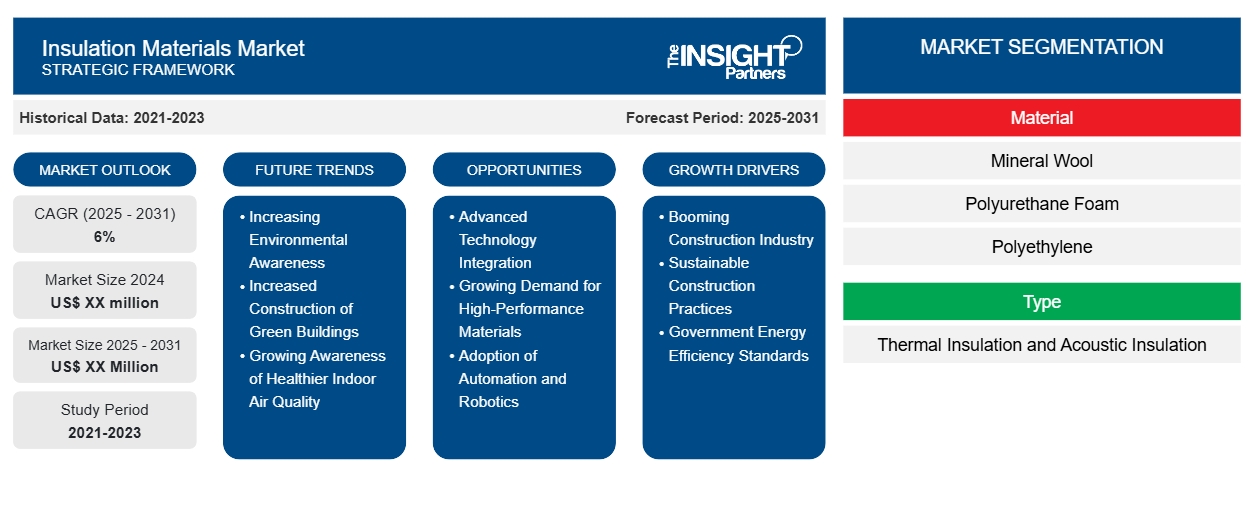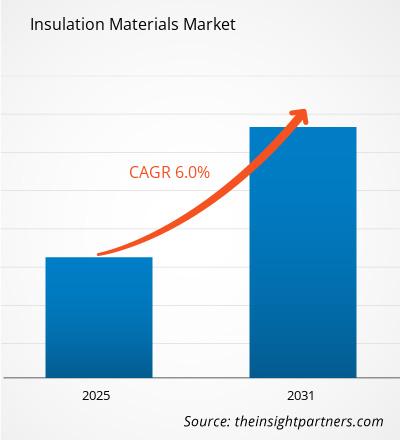Der Markt für Isoliermaterialien wird voraussichtlich von 2023 bis 2031 eine durchschnittliche jährliche Wachstumsrate (CAGR) von 6 % verzeichnen, wobei die Marktgröße von XX Millionen US-Dollar im Jahr 2023 auf XX Millionen US-Dollar im Jahr 2031 anwachsen wird.
Der Bericht präsentiert eine Analyse basierend auf dem Material (Mineralwolle, Polyurethanschaum, Polyethylen, Glasfaser, Polystyrol und andere). Der Bericht ist nach Typ (Wärmedämmung und Schalldämmung) segmentiert. Der Bericht ist nach Anwendung segmentiert (Automobil, Luft- und Raumfahrt, Schifffahrt, Elektrik und Elektronik, Bauwesen, Öl und Gas und andere). Die globale Analyse ist weiter auf regionaler Ebene und in die wichtigsten Länder unterteilt. Die Marktgröße und -prognose auf globaler, regionaler und Länderebene für alle wichtigen Marktsegmente werden im Rahmen abgedeckt. Der Bericht bietet den Wert in USD für die oben genannte Analyse und die Segmente. Der Bericht bietet wichtige Statistiken zum Marktstatus der wichtigsten Marktteilnehmer und bietet Markttrends und -chancen.
Zweck des Berichts
Der Bericht „Insulation Materials Market“ von The Insight Partners zielt darauf ab, die aktuelle Situation und das zukünftige Wachstum sowie die wichtigsten treibenden Faktoren, Herausforderungen und Chancen zu beschreiben. Dies wird verschiedenen Geschäftspartnern Einblicke geben, wie zum Beispiel:
- Technologieanbieter/-hersteller: Um die sich entwickelnde Marktdynamik zu verstehen und die potenziellen Wachstumschancen zu kennen, damit sie fundierte strategische Entscheidungen treffen können.
- Investoren: Durchführung einer umfassenden Trendanalyse hinsichtlich der Marktwachstumsrate, der finanziellen Marktprognosen und der Chancen entlang der Wertschöpfungskette.
- Regulierungsbehörden: Zur Regulierung von Richtlinien und Überwachungsaktivitäten auf dem Markt mit dem Ziel, Missbrauch zu minimieren, das Vertrauen der Anleger zu bewahren und die Integrität und Stabilität des Marktes aufrechtzuerhalten.
Dämmstoffe Marktsegmentierung
Material
- Mineralwolle
- Polyurethanschaum
- Polyethylen
- Glasfaser
- Polystyrol
Typ
- Wärmedämmung und Schalldämmung
Anwendung
- Automobilindustrie
- Luft- und Raumfahrt
- Marine
- Elektrik und Elektronik
- Bauwesen
- Öl und Gas
Geographie
- Nordamerika
- Europa
- Asien-Pazifik
- Süd- und Mittelamerika
- Naher Osten und Afrika
Geographie
- Nordamerika
- Europa
- Asien-Pazifik
- Süd- und Mittelamerika
- Naher Osten und Afrika
Passen Sie diesen Bericht Ihren Anforderungen an
Sie erhalten kostenlos individuelle Anpassungen an jedem Bericht, einschließlich Teilen dieses Berichts oder einer Analyse auf Länderebene, eines Excel-Datenpakets sowie tolle Angebote und Rabatte für Start-ups und Universitäten.
- Holen Sie sich die wichtigsten Markttrends aus diesem Bericht.Dieses KOSTENLOSE Beispiel umfasst eine Datenanalyse von Markttrends bis hin zu Schätzungen und Prognosen.
Wachstumstreiber auf dem Markt für Isoliermaterialien
- Boomende Bauindustrie: Der Markt für Dämmstoffe wird durch die boomende Bauindustrie angetrieben. Urbanisierung und steigende Bevölkerungszahlen führen zu einer steigenden Nachfrage nach neuen Wohn- und Geschäftsgebäuden. Die gestiegene Bautätigkeit erfordert qualitativ hochwertigere Dämmlösungen, um eine höhere Energieeffizienz zu gewährleisten und den heutigen Baustandards zu entsprechen.
- Nachhaltige Baupraktiken: Es gibt auch ein Bewusstsein für nachhaltiges Bauen, was den Bedarf an Isolierung erhöht. Die Energieeffizienz von Gebäuden ist heutzutage für jeden Bauherrn weltweit das größte Anliegen, da weniger Energieverbrauch und weniger Treibhausgasemissionen entstehen. Isolierung trägt zu diesen Zielen bei, und die Investition erfolgt in hochwertigere Isoliermaterialien, die Nachhaltigkeit gewährleisten und die Gebäudeleistung insgesamt verbessern.
- Staatliche Energieeffizienzstandards: Darüber hinaus fördern Regierungen, die Energieeffizienzstandards für Gebäude durchsetzen, das Wachstum. Die meisten Länder weltweit haben strenge Bauvorschriften und erhöhte Gebäudedämmungsstandards eingeführt. Höhere Dämmungsstandards erfordern, dass Bauunternehmen bessere Dämmmaterialien verwenden; daher steigt die Nachfrage nach Dämmstoffen auf dem Markt.
Zukünftige Trends auf dem Markt für Isoliermaterialien
- Steigendes Umweltbewusstsein: Das steigende Umweltbewusstsein macht biobasierte Dämmstoffe zu einem Vorreiter auf dem Dämmstoffmarkt. Verbraucher und Bauherren legen Wert auf Nachhaltigkeit, da Verbraucher sich für biobasierte Optionen wie Zellulose, Hanf und Wolle entscheiden, um mit relativ geringem Einsatz fossiler Brennstoffe eine effektive Wärmeleistung zu erzielen, was diese Option für die Umweltbedenken der Beteiligten attraktiv macht.
- Vermehrter Bau von umweltfreundlichen Gebäuden: Darüber hinaus steigern staatliche Richtlinien für umweltfreundliche Gebäude die Nachfrage nach Dämmstoffen auf biologischer Basis. Mehrere Länder haben Anreize und Vorschriften eingeführt, um die Verwendung „grüner“ Materialien im Bauwesen zu fördern. Eine solche politische Unterstützung fördert das Marktwachstum und regt Hersteller zu Innovationen bei der Entwicklung von Technologien für Dämmstoffe auf biologischer Basis an. Daher erweitern sie deren Anwendungsmöglichkeiten in verschiedenen Projekten.
- Wachsendes Bewusstsein für gesündere Raumluftqualität: Abgesehen von den Umweltvorteilen sorgen viele biobasierte Dämmstoffe auch für eine bessere Raumluftqualität. Viele der Produkte enthalten keine schädlichen Chemikalien, sodass Wohn- und Arbeitsumgebungen viel gesünder werden. Angesichts der wachsenden Besorgnis über die Raumluftqualität greifen Bauherren und Hausbesitzer eher auf biobasierte Optionen zurück, was wiederum die Nachfrage ankurbeln wird.
Marktchancen für Dämmstoffe
- Integration fortschrittlicher Technologien: Die Integration fortschrittlicher Technologien dürfte erhebliche Wachstumschancen auf dem Markt für Isoliermaterialien eröffnen. Intelligente Isoliersysteme, die Sensoren und IoT-Technologie verwenden, ermöglichen die Überwachung und Optimierung der Energieeffizienz in Echtzeit. Die durch solche intelligenten Isoliersysteme bereitgestellten Daten können den Benutzern zugutekommen, indem sie fundierte Entscheidungen hinsichtlich des Energieverbrauchs und der Wirksamkeit ihrer Isolierung treffen können.
- Wachsende Nachfrage nach Hochleistungsmaterialien: Darüber hinaus werden Hochleistungsmaterialien wie Vakuumisolationspaneele und Aerogele entwickelt, die die Dämmleistung rasant steigern. Diese fortschrittlichen Materialien bieten einen überlegenen Wärmewiderstand in dünneren Profilen und sind daher für Architekten und Bauherren interessant, die den Raum bei niedrigen Energiekosten maximieren möchten. Dieser Fokus auf Leistung fördert die Nachfrage nach hochmodernen Dämmlösungen.
- Einführung von Automatisierung und Robotik: Darüber hinaus werden durch Automatisierung und Robotik in den Herstellungsprozessen Produktionseffizienz und -kosten gespart. Dadurch können Unternehmen wettbewerbsfähige Preise mit hochwertigen Isoliermaterialien sicherstellen. Diese Produktivitätssteigerung wird zu weiteren Marktzugängen in neuen Regionen führen.
Regionale Einblicke in den Markt für Isoliermaterialien
Die regionalen Trends und Faktoren, die den Markt für Dämmstoffe im Prognosezeitraum beeinflussen, wurden von den Analysten von Insight Partners ausführlich erläutert. In diesem Abschnitt werden auch die Marktsegmente und die Geografie von Dämmstoffen in Nordamerika, Europa, im asiatisch-pazifischen Raum, im Nahen Osten und Afrika sowie in Süd- und Mittelamerika erörtert.

- Holen Sie sich die regionalen Daten für den Dämmstoffmarkt
Umfang des Marktberichts zu Isoliermaterialien
| Berichtsattribut | Details |
|---|---|
| Marktgröße im Jahr 2023 | XX Millionen US-Dollar |
| Marktgröße bis 2031 | XX Millionen US-Dollar |
| Globale CAGR (2023 - 2031) | 6 % |
| Historische Daten | 2021-2022 |
| Prognosezeitraum | 2024–2031 |
| Abgedeckte Segmente | Nach Material
|
| Abgedeckte Regionen und Länder | Nordamerika
|
| Marktführer und wichtige Unternehmensprofile |
|
Dichte der Marktteilnehmer für Dämmstoffe: Auswirkungen auf die Geschäftsdynamik verstehen
Der Markt für Isoliermaterialien wächst rasant, angetrieben durch die steigende Nachfrage der Endverbraucher aufgrund von Faktoren wie sich entwickelnden Verbraucherpräferenzen, technologischen Fortschritten und einem größeren Bewusstsein für die Vorteile des Produkts. Mit steigender Nachfrage erweitern Unternehmen ihr Angebot, entwickeln Innovationen, um die Bedürfnisse der Verbraucher zu erfüllen, und nutzen neue Trends, was das Marktwachstum weiter ankurbelt.
Die Marktteilnehmerdichte bezieht sich auf die Verteilung von Firmen oder Unternehmen, die in einem bestimmten Markt oder einer bestimmten Branche tätig sind. Sie gibt an, wie viele Wettbewerber (Marktteilnehmer) in einem bestimmten Marktraum im Verhältnis zu seiner Größe oder seinem gesamten Marktwert präsent sind.
Die wichtigsten auf dem Markt für Isoliermaterialien tätigen Unternehmen sind:
- Atlas Roofing Corporation
- BASF SE
- Bayer AG
- Bridgestone Corporation
- Evonik Industries AG
Haftungsausschluss : Die oben aufgeführten Unternehmen sind nicht in einer bestimmten Reihenfolge aufgeführt.

- Überblick über die wichtigsten Akteure auf dem Markt für Isoliermaterialien
Wichtige Verkaufsargumente
- Umfassende Abdeckung: Der Bericht deckt die Analyse von Produkten, Dienstleistungen, Typen und Endbenutzern des Marktes für Isoliermaterialien umfassend ab und bietet einen ganzheitlichen Überblick.
- Expertenanalyse: Der Bericht basiert auf dem umfassenden Verständnis von Branchenexperten und Analysten.
- Aktuelle Informationen: Der Bericht stellt durch die Abdeckung aktueller Informationen und Datentrends Geschäftsrelevanz sicher.
- Anpassungsoptionen: Dieser Bericht kann angepasst werden, um spezifische Kundenanforderungen zu erfüllen und die Geschäftsstrategien optimal anzupassen.
Der Forschungsbericht zum Markt für Isoliermaterialien kann daher dabei helfen, die Branchensituation und Wachstumsaussichten zu entschlüsseln und zu verstehen. Obwohl es einige berechtigte Bedenken geben kann, überwiegen die allgemeinen Vorteile dieses Berichts tendenziell die Nachteile.
- Historische Analyse (2 Jahre), Basisjahr, Prognose (7 Jahre) mit CAGR
- PEST- und SWOT-Analyse
- Marktgröße Wert/Volumen – Global, Regional, Land
- Branche und Wettbewerbsumfeld
- Excel-Datensatz



Report Coverage
Revenue forecast, Company Analysis, Industry landscape, Growth factors, and Trends

Segment Covered
This text is related
to segments covered.

Regional Scope
North America, Europe, Asia Pacific, Middle East & Africa, South & Central America

Country Scope
This text is related
to country scope.
Häufig gestellte Fragen
The growing demand for bio-based insulation materials is expected to be the key market trends.
Based on geography, Asia Pacific held the largest share of the insulation materials market due to rapid urbanization and industrialization in countries such as China and India have significantly increased construction activities. This surge in new residential and commercial buildings drives demand for insulation materials to improve energy efficiency and meet building codes.
Based on material, the polyurethane foam segment is expected to witness the fastest growth during the forecast period
The growing construction industry is driving the market growth.
Atlas Roofing Corporation; BASF SE; Covestro AG; Bridgestone Corporation; Evonik Industries; GAF; Huntsman International LLC.; Kingspan Group; ROCKWOOL International A/S; and Dow are some of the key players operating in the insulation materials market
The Insulation Materials Market is estimated to witness a CAGR of 6% from 2023 to 2031
Trends and growth analysis reports related to Chemicals and Materials : READ MORE..
The List of Companies
- Atlas Roofing Corporation
- BASF SE
- Bayer AG
- Bridgestone Corporation
- Evonik Industries AG
- GAF
- Huntsman International LLC
- Kingspan Group
- ROCKWOOL International A/S
- The Dow Chemical Company
The Insight Partners performs research in 4 major stages: Data Collection & Secondary Research, Primary Research, Data Analysis and Data Triangulation & Final Review.
- Data Collection and Secondary Research:
As a market research and consulting firm operating from a decade, we have published and advised several client across the globe. First step for any study will start with an assessment of currently available data and insights from existing reports. Further, historical and current market information is collected from Investor Presentations, Annual Reports, SEC Filings, etc., and other information related to company’s performance and market positioning are gathered from Paid Databases (Factiva, Hoovers, and Reuters) and various other publications available in public domain.
Several associations trade associates, technical forums, institutes, societies and organization are accessed to gain technical as well as market related insights through their publications such as research papers, blogs and press releases related to the studies are referred to get cues about the market. Further, white papers, journals, magazines, and other news articles published in last 3 years are scrutinized and analyzed to understand the current market trends.
- Primary Research:
The primarily interview analysis comprise of data obtained from industry participants interview and answers to survey questions gathered by in-house primary team.
For primary research, interviews are conducted with industry experts/CEOs/Marketing Managers/VPs/Subject Matter Experts from both demand and supply side to get a 360-degree view of the market. The primary team conducts several interviews based on the complexity of the markets to understand the various market trends and dynamics which makes research more credible and precise.
A typical research interview fulfils the following functions:
- Provides first-hand information on the market size, market trends, growth trends, competitive landscape, and outlook
- Validates and strengthens in-house secondary research findings
- Develops the analysis team’s expertise and market understanding
Primary research involves email interactions and telephone interviews for each market, category, segment, and sub-segment across geographies. The participants who typically take part in such a process include, but are not limited to:
- Industry participants: VPs, business development managers, market intelligence managers and national sales managers
- Outside experts: Valuation experts, research analysts and key opinion leaders specializing in the electronics and semiconductor industry.
Below is the breakup of our primary respondents by company, designation, and region:

Once we receive the confirmation from primary research sources or primary respondents, we finalize the base year market estimation and forecast the data as per the macroeconomic and microeconomic factors assessed during data collection.
- Data Analysis:
Once data is validated through both secondary as well as primary respondents, we finalize the market estimations by hypothesis formulation and factor analysis at regional and country level.
- Macro-Economic Factor Analysis:
We analyse macroeconomic indicators such the gross domestic product (GDP), increase in the demand for goods and services across industries, technological advancement, regional economic growth, governmental policies, the influence of COVID-19, PEST analysis, and other aspects. This analysis aids in setting benchmarks for various nations/regions and approximating market splits. Additionally, the general trend of the aforementioned components aid in determining the market's development possibilities.
- Country Level Data:
Various factors that are especially aligned to the country are taken into account to determine the market size for a certain area and country, including the presence of vendors, such as headquarters and offices, the country's GDP, demand patterns, and industry growth. To comprehend the market dynamics for the nation, a number of growth variables, inhibitors, application areas, and current market trends are researched. The aforementioned elements aid in determining the country's overall market's growth potential.
- Company Profile:
The “Table of Contents” is formulated by listing and analyzing more than 25 - 30 companies operating in the market ecosystem across geographies. However, we profile only 10 companies as a standard practice in our syndicate reports. These 10 companies comprise leading, emerging, and regional players. Nonetheless, our analysis is not restricted to the 10 listed companies, we also analyze other companies present in the market to develop a holistic view and understand the prevailing trends. The “Company Profiles” section in the report covers key facts, business description, products & services, financial information, SWOT analysis, and key developments. The financial information presented is extracted from the annual reports and official documents of the publicly listed companies. Upon collecting the information for the sections of respective companies, we verify them via various primary sources and then compile the data in respective company profiles. The company level information helps us in deriving the base number as well as in forecasting the market size.
- Developing Base Number:
Aggregation of sales statistics (2020-2022) and macro-economic factor, and other secondary and primary research insights are utilized to arrive at base number and related market shares for 2022. The data gaps are identified in this step and relevant market data is analyzed, collected from paid primary interviews or databases. On finalizing the base year market size, forecasts are developed on the basis of macro-economic, industry and market growth factors and company level analysis.
- Data Triangulation and Final Review:
The market findings and base year market size calculations are validated from supply as well as demand side. Demand side validations are based on macro-economic factor analysis and benchmarks for respective regions and countries. In case of supply side validations, revenues of major companies are estimated (in case not available) based on industry benchmark, approximate number of employees, product portfolio, and primary interviews revenues are gathered. Further revenue from target product/service segment is assessed to avoid overshooting of market statistics. In case of heavy deviations between supply and demand side values, all thes steps are repeated to achieve synchronization.
We follow an iterative model, wherein we share our research findings with Subject Matter Experts (SME’s) and Key Opinion Leaders (KOLs) until consensus view of the market is not formulated – this model negates any drastic deviation in the opinions of experts. Only validated and universally acceptable research findings are quoted in our reports.
We have important check points that we use to validate our research findings – which we call – data triangulation, where we validate the information, we generate from secondary sources with primary interviews and then we re-validate with our internal data bases and Subject matter experts. This comprehensive model enables us to deliver high quality, reliable data in shortest possible time.


 Holen Sie sich ein kostenloses Muster für diesen Bericht
Holen Sie sich ein kostenloses Muster für diesen Bericht